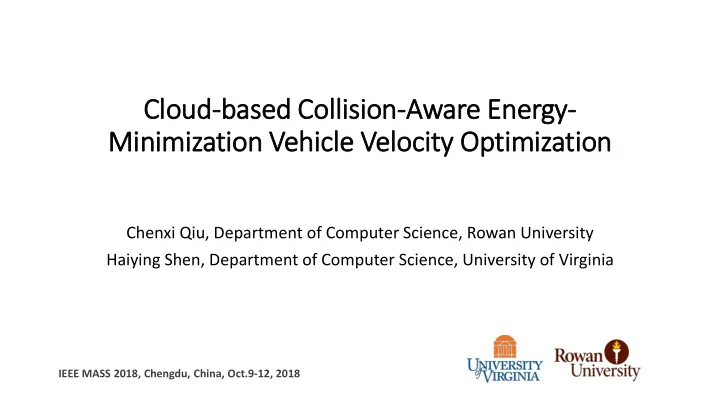

Clo loud-based Collision-Aware Energy- Min inimization Vehicle Velocity Optimization Chenxi Qiu, Department of Computer Science, Rowan University Haiying Shen, Department of Computer Science, University of Virginia IEEE MASS 2018, Chengdu, China, Oct.9-12, 2018
Outline • Background • System model • System design • Performance Evaluation • Conclusions IEEE MASS 2018, Chengdu, China, Oct.9-12, 2018
Background Decreasing vehicle energy consumption has been considered as an extremely important issue for transportation system. Optimizing vehicle velocity is one of the most effective methods to reduce vehicles’ energy consumption. IEEE MASS 2018, Chengdu, China, Oct.9-12, 2018
Background Existing work (vehicular cloud): consider each vehicle as an independent object and neglect the influence between consecutive vehicles in single lanes. Problem: Although a vehicle may pass its preceding vehicle through a neighboring lance, the influence between the consecutive vehicles in a single lane cannot be neglected, since most vehicles need to travel through single lanes in reality. IEEE MASS 2018, Chengdu, China, Oct.9-12, 2018
Background Challenge : 1) Non-convex constraints. 2) Difficult to process all vehicles’ information together. Contribution : 1) A time efficient solution to derive the optimal velocity. 2) Performance evaluation via real trace simulation. IEEE MASS 2018, Chengdu, China, Oct.9-12, 2018
System Model Vehicle traffic model : K vehicles are running on the roads; each vehicle’s travelling route and time constraint are given. The road can modeled as a map G = ( P , E ), as shown on the right. IEEE MASS 2018, Chengdu, China, Oct.9-12, 2018
System Model Vehicle energy consumption model : (comprehensive model mission model) IEEE MASS 2018, Chengdu, China, Oct.9-12, 2018
System Model Problem Formulation Constraint 1) Speed limit constraint 2) Driver’s comfort constraint 3) Stop sign constraint 4) Traffic light constraint 5) Vehicle influence constraint Objective function Minimize the overall energy consumption: IEEE MASS 2018, Chengdu, China, Oct.9-12, 2018
System Desig ign Step 1: Green traffic signal time interval identification. Step 2: Velocity optimization. Architecture of our system IEEE MASS 2018, Chengdu, China, Oct.9-12, 2018
System Desig ign Constant velocity principle Given the time limit T and the travel distance D , the vehicle’s total energy consumption is minimized when the vehicle’s velocity is constant at each time point. Proof : Power means inequality IEEE MASS 2018, Chengdu, China, Oct.9-12, 2018
System Desig ign Green traffic signal time interval identification IEEE MASS 2018, Chengdu, China, Oct.9-12, 2018
System Desig ign Velocity optimization The vehicle’s velocity is scheduled sequentially. Each schedule should avoid the collision with the previous scheduled vehicle. The newly formulated problem has only linear constraints. IEEE MASS 2018, Chengdu, China, Oct.9-12, 2018
Performance Evaluation Settings: 1. Vehicle mobility trace from the Cologne urban area, covering a region of 400 square kilometers with 404 traffic lights. The trace records the locations of more than 700,000 individual vehicle trips for a time period of 24 hours. 2. We randomly picked up a number of vehicles (the number is changed from 1000 to 2000). Methods for comparison: 1. PCC (predictive cruise control) 2. DP (dynamic programming) IEEE MASS 2018, Chengdu, China, Oct.9-12, 2018
Performance Evaluation Simulation: the total number of velocity violations IEEE MASS 2018, Chengdu, China, Oct.9-12, 2018
Performance Evaluation The total energy consumption IEEE MASS 2018, Chengdu, China, Oct.9-12, 2018
Performance Evaluation How vehicle follow the suggested velocity under the three methods IEEE MASS 2018, Chengdu, China, Oct.9-12, 2018
Conclusions 1) We formulated a new velocity optimization problem to consider the possible interaction between vehicles. 2) We proposed a time efficient solution to derive the optimal velocity. 3) We evaluated the performance of our solution via real trace simulation. Future work: 1) Interaction among vehicles in multiple lanes. 2) How to avoid the collision with human-determined vehicles. 3) How to optimize other metrics, like reducing vehicles’ traveling time. IEEE MASS 2018, Chengdu, China, Oct.9-12, 2018
Thank you! If you have any questions, please contact Chenxi Qiu, email: qiu@rowan.edu IEEE MASS 2018, Chengdu, China, Oct.9-12, 2018
Recommend
More recommend